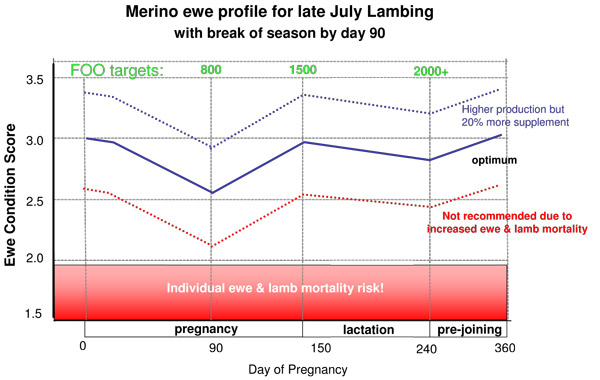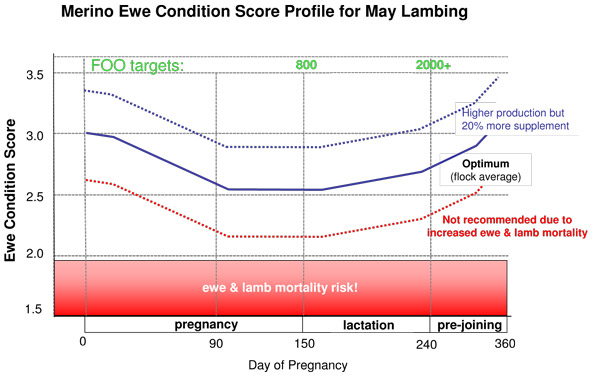|

This zone is
characterised by winter
rainfall and a mix of annual
grasses and sub clover. Due
to a longer growing season
than the cereal zone there
are differences in pasture
growth rates and total feed
on offer produced. This
affects the potential
stocking rate and pasture
utilisation and therefore
affects the recommendations
for ewe management.
Condition Score
Profiles:
There is no universal optimum
production system and the
'optimum' ewe CS targets
will differ for different
environments, production
systems (e.g. genotype, time
of lambing, flock structure)
and commodity prices. The
economic analysis that
supports these
recommendations is generated
using the Great Southern MIDAS
model. Download
a full report of
the modelling for this
region
(250kB PDF)
Late Lambing
(late pregnancy on green
feed) for Merino
ewes

(click on image
for printable
version)
The
optimum profile for
spring lambing
flocks in the Medium
Rainfall Zone in WA
is:
-
to allow
moderate loss of
condition from
joining to day
90, provided the
condition can be
regained prior
to lambing on
green
feed
-
aim for
Condition Score
3 at joining
Ewes can lose some
condition (0.4 of a
condition score)
over early
pregnancy,however,
they must
regain all condition
lost in early
pregnancy by
lambing.
Failing to meet this
lambing target will
decrease the value
of the ewe's
production by $11
per condition score.
It costs at least
$16/ewe to gain a
condition score with
grain feeding.
Therefore gaining
condition must be
done with green
feed.
This lose and regain
profile is more
profitable than
other profiles due
to
a lower
supplementary feed
bill over autumn,
better use of
emerging pasture and
that there is a
compensatory gain
effect on lamb
survival if ewes
increase their
condition in the
last 1/3 of
pregnancy.
Early
Lambing (late
pregnancy on dry
feed)
for Merino
ewes

(click
on
image
for
printable
version
)
The
profitability
of early
lambing
flocks is at
least half
that of
later
lambing
flocks for a
merino
enterprise
($71
compared to
$171).
This is due
to lower
stocking
rates and a
poorer match
of pasture
feed to
animal
demand.
The optimum
profile
for May
lambing
flocks in the
Medium Rainfall
Zone region is:
-
to allow
moderate
weight loss
from joining
to day 90
and then
maintenance
of weight
through to
lambing.
-
aim for
CS3.0 or
above at
joining
-
aim for no
lower than
CS 2.6 by
lambing
It is not
profitable for
ewe flocks to
regain weight
prior to lambing
because the only
feed available
to achieve this
is grain and it
is too
expensive.
These graphs outline the
targeted CS profile and acts as
a constant reference for how
your mob is performing. Print
out and plot the Condition Score
of your mob against the targeted
CS profile, so that by the end
of the year you have a CS
profile for your own ewes.
Remember - ewe CS for joining
can be influenced from weaning
and therefore it is important to
monitor changes in ewe condition
between weaning and joining.
or choose further information
on key topics (in the
"ewe management"
section)
How whole farm
profit is affected
by the condition of
ewes
Improving
ewe fleece weight and
wool quality
Ewes
in better condition at
joining conceive more
lambs
Improving
lamb survival
More
productive lambs through
better ewe
management
Managing
twinning ewes for higher
production
Managing
ewe mortality
Tools including
Pasture photos, condition
scoring and feed budgeting
For more information on
lifetimewool in Western
Australia please contact:
Mandy
Curnow, DAFWA,
Albany 08 98928444
|